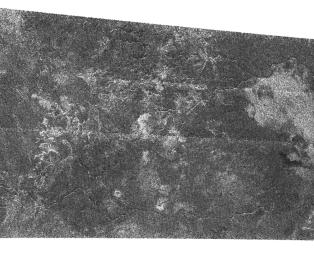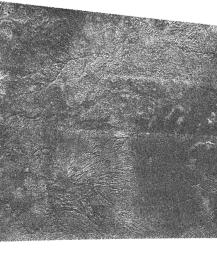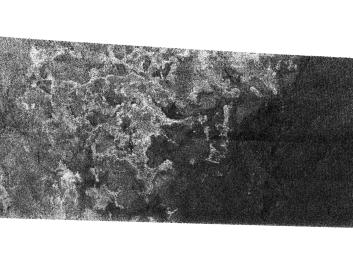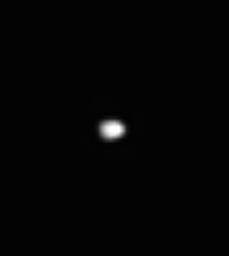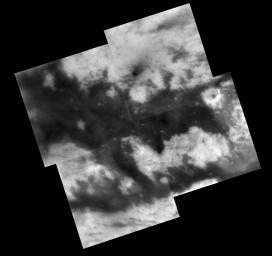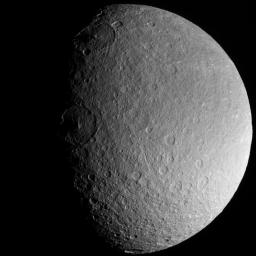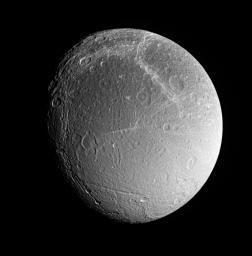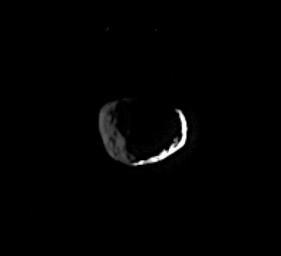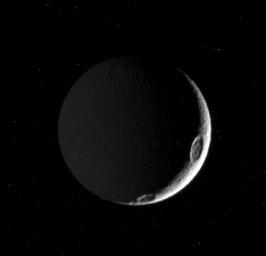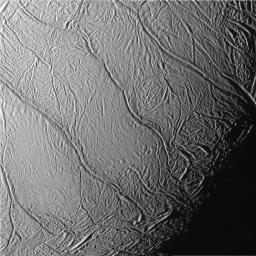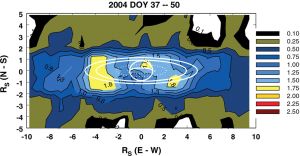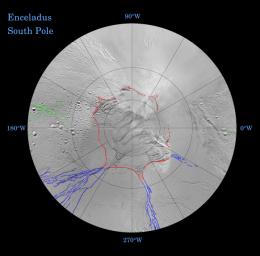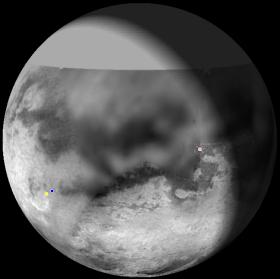 View of Titan from Cassini 2 hours into ISS' high resolution observation, about 3 hours prior to closest approach (sub-spacecraft point=4.4N, 26.2W). The plot was generated in GISS' Titan 24 software. The map is derived from ISS map released in March (ask for full version used here, just adds blank space north of 34N). The full version of above plot is available as well as one with feature labels. The data for plot was obtained from Mission description document.
View of Titan from Cassini 2 hours into ISS' high resolution observation, about 3 hours prior to closest approach (sub-spacecraft point=4.4N, 26.2W). The plot was generated in GISS' Titan 24 software. The map is derived from ISS map released in March (ask for full version used here, just adds blank space north of 34N). The full version of above plot is available as well as one with feature labels. The data for plot was obtained from Mission description document.T7 Quick-facts:
- Closest approach occurs on September 7 at 1:33 am PDT
- Closest Approach Distance = 1075 km (bumped up from 950 km)
- Relative speed WRT Titan = 5.9 km/sec
- Closest Approach Lat and lon = 67 South, 308.1 West
- South Polar Pass with sub-Saturnian hemisphere visible inbound
- Outbound flyby (sunlit inbound)
- Phase angle at -3hours = 51.5 deg.
RADAR SAR and ISS imaging highlight the science plans for tonight's T7 flyby of Titan. This is the 8th flyby of Titan out of 45 planned for the nominal mission. The 7th flyby, T6, took place on August 22, and yielded plenty of data for CIRS and MAPS, but not much for the other remote sensing instruments. However, during T7, RADAR, ISS, and VIMS make up for lost time.
This flyby is lower than the August flyby, with Cassini coming within 1075 km of the surface of Titan. This is higher than the originally planned 950 kilometers. Many of the 950 km flybys may have to be similarly raised due to higher atmospheric densities at higher altitudes than expected. As you can see in the above plot, Cassini will once again look at the sub-Saturnian hemisphere of Titan on its inbound leg. This hemisphere has been in view of the last 3 flybys, but have no fear, Cassini will return to the anti-Saturnian hemisphere and the Shangri-la region during T8 in late October.
ISS controls the spacecraft for much of the period prior to closest approach. Two large mosaics are planned. The first is a mosaic at about 10 hours out. This should have similar coverage and resolution to the global mosaics taken during
Ta and
T3, global with a resolution of about 2 km/pixel. The second is a higher resolution mosaic taken from 5 hours out to about 1 hour out. The coverage map for this mosaic should be out soon, but this mosaic would have enough time to build up a large mosaic with similar coverage and resolution to those taken on
Ta and
Tb. Overall this is shaping up to be one of the better flybys for ISS in some time. Phase angles are similar to those from the past few orbits, higher than those from Ta-Tb-T3. Lots of interesting features at the center of the disk including Bazaruto Facula (with an 80-km wide crater at its center), Quivira with its possible channels and a debris deposit bisecting the feature and flowing into Northeast Aztlan, and Omacatl Macula.
RADAR is back for T7. So far, RADAR has acquired two SAR (synthetic aperature radar) swaths, first on Ta and again on T3. Both swaths covered portions of the northern leading hemisphere. On this encounter, RADAR SAR will acquire a swath over the southern sub-Saturnian hemisphere. I have produced a
coverage plot for this swath, though I would ask that it not be reproduced on other sites. The swath starts out in north central Tsegihi, an area of bright terrain, which appears to be similar to Xanadu but slightly darker in albedo. Like Xanadu, Tsegihi is a region of mottled terrain, though with less contrast than Xanadu. Continuing along, RADAR will run into Mezzoramia, a "dinosaur-shaped" dark region that maybe a temporary reservoir of seasonal rainfall run-off from the south polar region. Images of Mezzoramia from July of last year indicated a possible difference in how sharp the southern and eastern boundary is compared to the western and northern boundary. It will be interesting to see if such a difference is detected in the RADAR coverage of the region. The SAR swath continues to as far south as 77 degrees south Latitude, even farther south than Ontario Lacus, a 235-km wide dark feature that maybe a lake. Many of the lake-like features near the south pole appear to concentrated on the leading hemisphere side of the pole, though this could be an emission angle effect (surface contrast improves as you approach the sub-spacecraft point). So RADAR SAR may miss most of the larger "lakes", but smaller features, like those seen on Ta, are possible. T0 images reveal a possible dark feature that maybe similar to Ontario Lacus to the southeast of Mezzoramia, near 70 South, 330 West, so that might be something to look out for. The eastern half of the SAR swath is in a region not seen very well by Cassini ISS (best pixel scale ~ 35 km). This region could be very similar to the area seen by RADAR on Ta, with a lot bland terrain puntuated by the occasional volcanic center.
RADAR also has altimetry and radiometry on this pass. Altimetry will cover the bright-dark southern boundary of Chang-tu at the far eastern end of the RADAR SAR swath. There should be altimetry at the far western end as well, checking for topography associated with Shiwanni Virgae and north-central Tsegihi. Hopefully, the altimetry won't show a slope to the east this time ;-) RADAR Radiometry will look at the thermophysical properties of the northern anti-Saturnian hemisphere, to compare with results from Ta, which looked at the northern sub-Saturnian hemisphere. This data, taken after closest approach, will cover the region that will be seen by RADAR SAR in late October during T8, an east-west swath that will cover central Belet and central Adiri. This region will also be see quite a bit by the remote sensing instruments, like ISS, later in the mission.
Of course, other instruments will gather data during this encounter. UVIS has their second star occultation of Titan's atmosphere, this time using alpha Pegasus (Markab). UVIS will be using the occultation to look for N, N
2, and hydrocarbons at various latitudes. This is a "glancing" occultation since the star will not pass behind the limb of Titan, only the upper atmosphere. The December 2004 occultation of lambda Sco allowed UVIS scientists to detect various hydrocarbons like methane, acetylene, diacetylene, ethane, ethylene, as well as Hydrogen cyanide in Titan's atmosphere as well as measure the abundances of those species. VIMS is prime for almost 4 hours on approach to Titan, starting around 8 hours and 45 minutes before closest approach. This will allow VIMS to create a full-disk mosaic similar, but at lower resolution, to our MONITOR mosaic taken shortly before VIMS' MEDRES observation. VIMS will also take a few snapshots near closest approach northeast of Shiwanni Virgae. CIRS and the Fields-and-Particles instruments will also be active on this encounter. CIRS will be continuing to look for variations in the distribution of hydrocarbon species both temporally and spatially. The MAPS instruments, like MAG and MIMI, will continue to examine the interaction between Titan and Saturn's magnetosphere.
Playback of T7 data takes place during two playback periods. The ISS images of the surface will be returned tomorrow night and Thursday morning and should show up on the JPL raw images page Thursday afternoon, PDT. The rest of the data will be played back starting at around 5:30 am Friday morning, PDT and will continue until around 2 pm PDT. Images from this period, mostly from after Closest approach, should be on the raw images page Friday evening. RADAR SAR data will be played back during this playback period, so don't expect any data from them to show up until at least Monday, and even that is pushing it. Given the weekend and the fact that a number of RADAR team members are in transit from the DPS conference that takes place this week, I wouldn't expect any images from the RADAR team until at least Wednesday. I know that's a long time, but we should have patience with the RADAR team in getting their data assembled.
